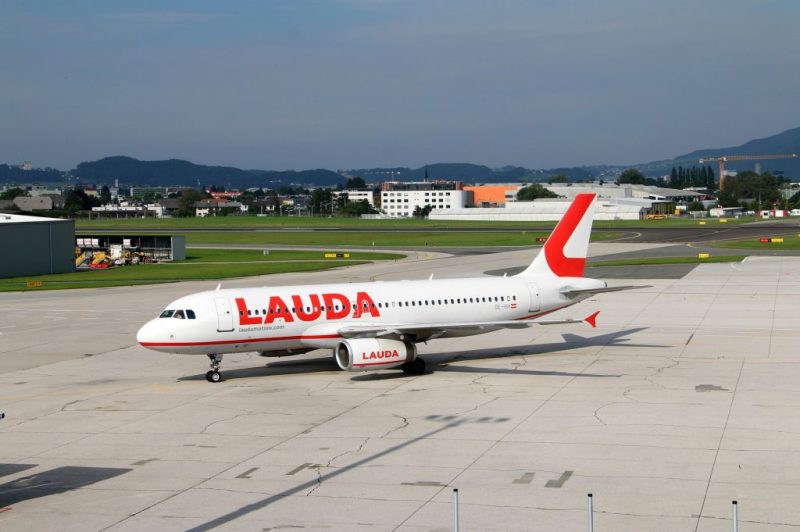On March 1, 2019, the OE-LOA, operated by Lauda, was evacuated at Stansted Airport after a left engine malfunction. In their report, the British accident investigators strongly criticize the processes on board and come to the conclusion that the evacuation was not necessary.
The decision to evacuate, which was made by the senior flight attendant without consulting the cockpit, is particularly heavily criticized. Investigators write in theirs Message also that there would be a lack of communication and experience. The captain gave the instruction: "Attention Crew: On Station". The cabin manager does not want to have heard this command. She used the intercom to talk to another flight attendant who is said to have been shocked and scared. The SFA then gave the order to evacuate. However, according to the report, there was no consultation with the captain.
Cabin crew lack of experience
With regard to the experience of the senior flight attendant, the authority criticizes the fact that she obtained the qualification as a junior flight attendant in May 2017. Due to the bankruptcy of her employer at the time, she did not fly between December 2017 and March 2018. She completed her senior training in May 2018, which she passed with a positive result. The authority notes that the previous experience could possibly have been inadequate.
The accident investigators rated it as risky that the right engine was still in operation for a few minutes at the time the aircraft was cleared and the pilots stated that they were surprised to suddenly see passengers around the Airbus A320. There was no instruction from the cockpit, the pilots are quoted in the report.
The way in which the passengers left the OE-LOA have also been criticized. The cabin crew disregarded the recommendations of the EASA and did not prevent them from leaving the Airbus A320 via the slides including hand luggage. There was an announcement to this effect, but many of the passengers interviewed did not want to have heard or perceived it. The British authorities expressly point out that there is a need for follow-up training at Lauda and have made recommendations in this regard. However, the accident investigators also admit that it was clear afterwards that the evacuation was not necessary, but was fundamentally correct according to the “Safety First” principle, since at the time of the decision it was not possible to rule out any risk to the crew and passengers without any doubt . However, the way in which it was carried out has come under criticism.
The fact that the right engine was still in operation while passengers immediately next to it left the aircraft via the chute is a fact that British investigators are heavily criticizing. Special recordings also show that the hand luggage even hindered the evacuation and slowed down the passengers when they left the possible danger zone.
The left engine was defective before it was handed over to Lauda
The engine (SN: 697283) has been in use since 2007. It has not been changed since it was delivered to an Indonesian airline. Investigators write that numerous defects were found in the course of the return to the lessor, which led to its removal and subsequent repair at an engine overhaul facility in Indonesia. During the repair process, the IGV and VSV actuation rings are split to replace the top half of the HPC housing (front stator) around two damaged HPC blades. This included dismantling the connection connections on the IGV and VSV actuating rings. After the repair was completed, no other defects were found in Indonesia.
The British investigators also found that the airline Lauda did not carry out any further maintenance work on the left engine after taking over the machine on December 22, 2018: “The operator received the aircraft registered as OE-LOA on December 22, 2018. Until the accident, no maintenance work had been carried out on the left engine, apart from the routine oil topping up, and there were no relevant deficiencies in the technical log. At the time of the accident, the engine had accumulated 513 hours and 220 cycles since the engine was repaired. "
In the analysis, the investigators summarized the engine as follows: The left engine had a closed fault as a result of the release of several HPC blades of level 1. The blade faults were caused by cracks due to HCF with ultimate failure due to tensile overload. Several other blades also showed fatigue initiation in the blade's dovetail. The fatigue failures on the exposed vane fracture surfaces were consistent with the failure due to a known aerodynamic excitation phenomenon resulting from an out of schedule IGV / VSV condition that creates stresses in the vane that are beyond design limits.
An IGV lever arm was found to be disconnected from the link on the IGV actuator ring and would have provided the stimulus for aerodynamic excitation. Compared to other blade release events resulting from improper engagement of the IGV / VSV lever arms with the link, ESN 697283 demonstrated low downtime. The magnitude of the excitation force, and thus the time to failure, depends on the extent to which the affected blade is out of schedule (the angle between it and the other blades). The fact that the lever arm was completely detached from the link and the blade could therefore move freely could have influenced the comparatively short time to failure. The release of the Stage 1 HPC blades resulted in the separation of all IGVs and the forces exerted by the blades would have been transferred to the actuation ring via the lever arms. The absence of damage to the severed lever arm indicates that it was severed from the link prior to and not as a result of the engine failure. The IGV operating ring links were removed and reassembled during the last engine repair, and it is likely that a lever arm misassembly occurred at this point.
The appropriate ESM task provides instructions for a visual inspection to verify proper installation of the lever arms. However, the incorrect assembly was not detected by the maintenance personnel during the installation of the IGV connecting link, the visual inspection or during other maintenance work in the immediate vicinity of the lever arm. As the assembly of the engine progressed, it is unlikely that the disconnected IGV lever arm would have been easily identified as it would have been obscured by the external hoses, pipes and brackets. It is also very unlikely that engine runs have discovered an improperly installed IGV lever arm after servicing.
The time between engine repair and subsequent investigation, and the lack of particularly memorable information about the link installation, resulted in limited information available on the factors that may have contributed to the IGV lever arm being improperly assembled. The engine manufacturer stated that it regards incomplete installation of components as a "common skill-based mistake". Additional training or revisions of the maintenance documentation have generally proven ineffective in preventing improper installation of the components. In general, only design solutions or a fault tolerant design from the start can reliably prevent such occurrences. The engine manufacturer has taken these aspects into account and has determined that adding further instructions in the ESM is unlikely to be an effective mitigation. Mitigating or eliminating the possibility of an improperly assembled IGV / VSV lever would require redesign of the engine which is not considered feasible due to the low rate of occurrence. It was also suggested that the limited space, concentration of moving parts, and engine temperatures in the vicinity of the IGV / VSV actuating rings would preclude the installation of a poster to highlight the correct installation of the IGV / VSV connectors.
The engine manufacturer presented at a conference for all operators in June 2019 on the subject of improper IGV / VSV lever arm assembly and its consequences and published an article in its monthly publication "Fleet Highlites", which is available to all CFM operators and approved overhaul facilities in January 2020 This topic should also be emphasized in discussions with representatives of the field service for passing on to operators and overhaul facilities. There is currently no other way to identify an incorrect lever arm assembly other than a visual inspection. The engine manufacturer recently implemented an HPC performance analysis tool that can detect shifts in HPC efficiency. Relevant warnings from the analysis tool are communicated to the operators. While there is currently insufficient experience with the analysis tool to determine whether the effects of an improperly installed lever arm could manifest as a noticeable shift in engine performance, the engine manufacturer intends to evaluate this possibility as it becomes more experienced with the tool. "







 trail (for them it's free to use)
trail (for them it's free to use)